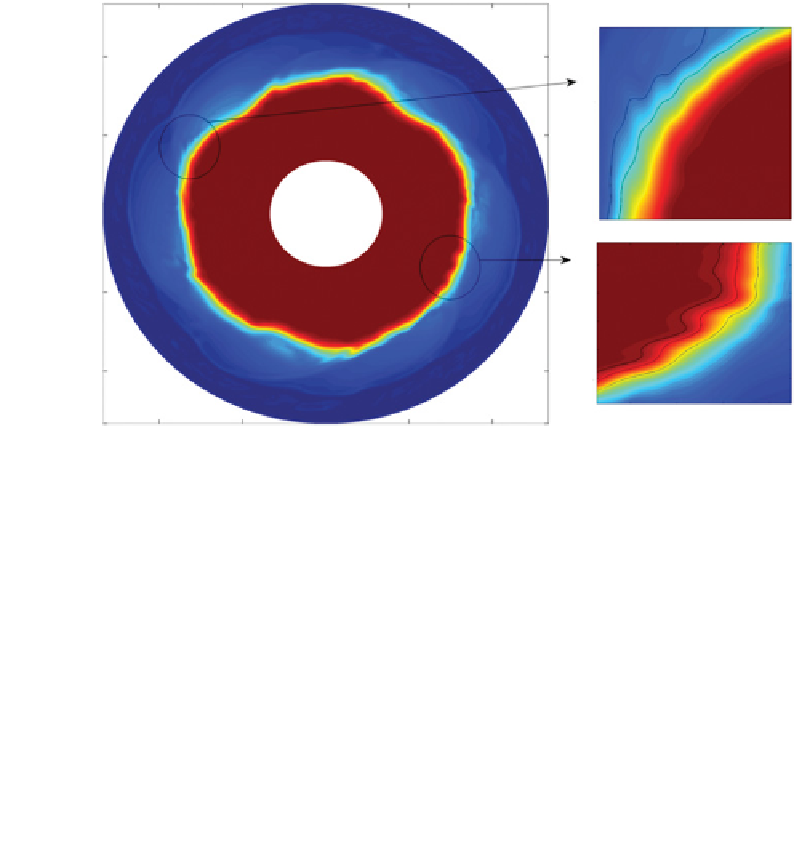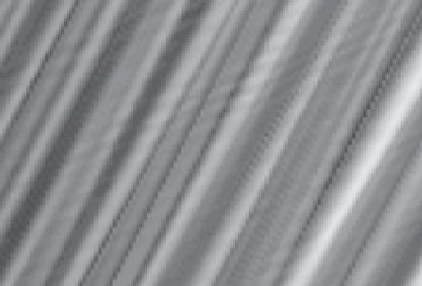Geoscience Reference
In-Depth Information
1
1
0.5
0.9
0.4
0.8
0.5
0.7
0.3
0.6
0.2
0
0.5
-0.9
-0.8
-0.7
0.4
-0.1
0.3
-0.5
-0.2
-0.3
-0.4
-0.5
0.2
0.1
-1
0
0.7
0.75
0.8
0.85
-1
-0.5
0
0.5
1
Figure 11.13.
Density front for 3D simulation with Sc = 100 for
N
θ
×
257, Bu = 0.62, and Ro = 0.67.
Right: zoom in on the encircled area showing the small-scale perturbations. For color detail, please see color plate section.
N
r
×
N
z
= 1201
×
301
×
a unidirectional shear layer. For large Schmidt numbers
the Ekman layer can be maintained until entrainment
modifies the density and velocity distribution.
Small-scale waves have been observed in all experiments.
In laboratory experiments, the precise interface conditions
are generally not known, so that it is difficult to determine
whether Hölmböe, Kevin-Helmhotlz, or other instabilities
may occur. Their existence depends on the value of the
global Richardson number and the value of the interface
thickness ratio,
R
. The knowledge of the Ekman layer and
density layer thicknesses in the work of
Williams et al.
[2005] allows for an accurate estimation of
R
, in con-
trast to the modeling with miscible fluids in continuously
stratified fluids. Varying the Schmidt number modifies the
eventual interface thickness. The numerical results show
that, only at the start of the experiment when diffusion
processes dominate because of the thin interface, the ini-
tial value of
R
may be smaller as well as larger than 2.
Eventually, when entrainment processes dominate,
R
tends to a minimal value of 2 whereafter it increases again.
A linear diffusion of density and momentum would
suggest diffusion rates and related layer thicknesses that
are reflected directly by the Schmidt number value. The
present results indicate that even for the low values
of Sc values in the atmosphere (Sc= 1) and the ocean
(Sc= 7), Hölmböe waves could occur, and the ratio
R
tends to a value of 2 and increases again afterward
(see Figure 11.12) thus allowing for Hölmböe instability.
The RK instability in geophysical flows has so far
not been considered. At difference with the baroclinic
instability, the Kelvin waves that resonate with the
Rossby wave for instability need a boundary along which
6
5.5
5
4.5
4
3.5
72
73
74
75
76
77
78
79
80
81
82
Time (s)
Figure 11.14.
Hövmöller diagram, with small-scale perturba-
tions located between the dashed white lines superimposed on
the larger wave modes. The small-scale perturbations propagate
much slower than the large wave mode. Numerical parameters
are as in Figure 11.5.
Internal Ekman layers are considered in relation to
interface conditions for different Schmidt numbers. In
ageostrophic flows (i.e. for larger Ro numbers) there is an
internal Ekman layer when the interface is sharp. But there
is a transition to a shear layer (without Ekman pump-
ing) for thicker interfaces and when the Ro number is
really small, i.e.,
O(
0.005
)
. In the latter case, the charac-
teristic properties of an Ekman layer (Ekman pumping
and vertical circulation) are lost. The effect of strong
density diffusion (small Schmidt number) on the Ekman
layer is that the Ekman layer disappears and turns into


























































